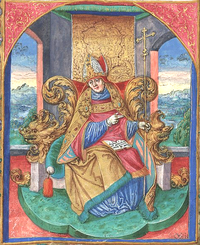House
of Jagiellon
 Other Gediminids
Other Gediminids
House
of Angevin
House
of Luxembourg
House
of Habsburg
Other
After Sigismund II Augustus, the dynasty underwent further changes. Sigismund II's heirs were his sisters, Anna Jagellonica and Catherine Jagellonica. The latter had married Duke John of Finland, who thereby from 1569 became king John III Vasa of Sweden, and they had a son, Sigismund III Vasa; as a result, the Polish branch of the Jagiellons merged with the House of Vasa, which ruled Poland from 1587 until 1668. During the interval, among others, Stephen Bathory, the husband of the childless Anna, reigned.
4. Jagiellon family
5. Bohemia and Hungary
The Jagiellons at one point also established dynastic control over the kingdoms of Bohemia (1471 onwards) and Hungary (from 1490 onwards), withWladislaus Jagiello whom several history books call Vladisla(u)s II.
Jagiellon Kings of Bohemia and Hungary:
- Vladislaus II of Bohemia and Hungary (Vladislaus Jagiello)
- Louis II of Hungary and Bohemia (Louis Jagiello). By Louis' sudden death in Battle of Mohács in 1526, that royal line was extinguished in male line.
- Anna of Bohemia and Hungary, Queen consort, sister of Louis. Her husband Ferdinand I, Holy Roman Emperor was elected king of Bohemia based on her rights. He was also elected King of Hungary in dispute at first with John Zápolya and then with John II Sigismund Zápolya.
6. Maturity pattern
Anthropologists have noted the tendency of members of the Jagiello dynasty to marry late in life, and not procreate until older. Most of its males over the dynasty's two centuries (approximately between 1360 and 1560) managed to have their heirs only when well into their middle years.
This contrasts with the later Bourbons and Habsburg-Lorraines, prolific Roman Catholic dynasties, whose members usually started to produce offspring while still in their teens. Also, interestingly enough, those Jagiellons who continued the line, lived to ripe old ages, while those who died in their twenties or thirties, generally did not leave children. Because the average life span was relatively short in that time period, this habit of starting to produce children late axed many potential branches from the dynasty, since persons who were generally potential parents, did not start procreating until their thirties.
This was no coincidence. In this dynasty, "maturity" and willingness to settle down occurred only later in life, not in one's twenties. It has been speculated that cultural reasons may have also been co-factors. However, it has been proposed that inherited features were the chief reason. Some female-line descendants within a couple of generations showed similar tendencies, such as Charles II, Archduke of Inner Austria, and Albert VII, Archduke of Austria. However, the tendency later diminished, and after the 17th century, all members resumed the trait of having their children at a young age.
This tendency to bear children late weakened the potential of the dynasty compared to others of same era. After just four generations, the dynasty went extinct in its male line. But those same four generations lasted two centuries, averaging approximately fifty years between siring each new generation:
- Algirdas (1291-1377), Ladislaus (1351-1434), Casimir IV (1427-92), Sigismund I (1467-1548) and Sigismund II (1520-72).
- Algirdas (1291-1377), Ladislaus (1351-1434), Casimir IV (1427-92), Ladislaus II (1456-1516) and Louis (1506-26)
(Generational chart: Zeroeth interval 60/60 years, first interval: 76/76 years, second interval 29/40 years, third interval 50/53 years)
Monarch Birth - death Age at birth of first childto survive to adulthood Age at birth of first child Ladislaus 1351-1434 57 48 Casimir IV 1427-1492 29 29 Sigismund I 1467-1548 46 46 Ladislaus II 1456-1516 47 47
Sometimes, women of this dynasty married only when relatively old. Catherine Jagiellon, wife of John III of Sweden, was 11 years older than her husband, having remained unmarried into her thirties. She bore her children at ages 38, 40 and 42.
Jagiello himself was born to a father already in his fifties or sixties.
7. See also
- List of Lithuanian rulers
- List of Polish rulers
- List of Hungarian rulers
- List of Czech rulers
- Jagiellonian University in Kraków







